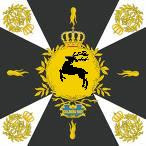First and foremost, thanks to all for the offers of commander employment – I’ll pick one and respond in the next day or two.
I’ve decided, what with the build-up of the two armies, that terrain needs a bit of a sprucing up. I bought some model railway trees to use, which look very nice, but the really ambitious bit is the home-made terrain. Following on from my decision in the last post to include some field fortifications, I’d been pondering making a model and scratching my head about how to succeed.
Eventually I headed to the local hobby shop, bought a 2mm thick plastic sheet for the base, plus some non-firing modelling clay. I marked out a base area of 60mm square (two of my 60x30mm bases, back to back) and then added a 30mm border to the back and sides. I cut this out, rounding the corners, and then scratched up the surface of the borders to let the clay get a grip.
Next, I started getting clay and rolling it into sausages of roughly 1cm thick, which I chopped up into rough cylinders and placed around the base area to look like gabions. Once done, I added lots of clay to the outside and built up a parapet of excavated earth – taking care to leave a lower gabion in the middle, so any artillery wouldn’t look too implausible in residence. I also used a spare base edge to press ridged lines into the inner gabion faces, to indicate the wicker basket-weave patterning.
And that’s it. The whole thing took only about 30 minutes of sit-down modelling time, and that was with correcting my errors. For the benefit of others, these were that a) the gabions will creep inward as you press on the outer mounds of earth/clay, so you need to constantly check the bases still fit in and leave room for error; and b) check your gabion heights against your based figures, as my first efforts came up to a disappointing waist-height – something of a design flaw! Still, easily corrected with some top-up clay.
I know what you’re thinking – what does it look like? Well, here’s the latest workbench photos:




The whole thing should really help out with Luftberg’s defences in the coming scrap along the road. After all, who ever heard of a belligerent Austrian coming to grief in a bunker? J






8 comments:
Good work, sir.
-- Jeff
looks good, please post again when painted up.
Very nicely done! I really like the way your photos can be blown up. keep up the good work...Bill
Looks very good!
You said non-firing clay - does that mean it's self-hardening (air-dry?)? or is it like plasticine, always stays pliable? If it's self-hardening is there shrinkage (which could cause it to pull away from the plastic base or warp it)?
Is this a "one-off" or have you thought about making a mold and casting multiples?
A very impressive piece of work. I made something similar out of clay and matchsticks years ago, and strained my eyes in the process. Your method is a lot simpler and more effective.
Thanks all - the clay apparently air-dries after a few days, and so far there thankfully appears to be little in the way of shrinkage. It's just a one-off project, but it appears to have gone quite well so I may make some straight sections of entrenchments, in order to play games with a fortified camp.
I'd say the main surprise was how much easier it was than I'd feared - so if you've a personal project hanging about, my advice would simply be: give it a go!
nice looking redoubt
-- Allan
Looking Good Sir!
Post a Comment